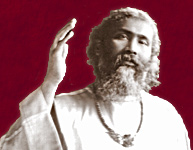Ya Hazrati Inayat - Winged Heart Tughra
Sufi orders frequently have a tughra (an Arabic word meaning finely ornamented writing), which is emblematic calligraphy formed using the name of the founding patron saint of the order, often in a unique shape related to the traditions of that order. The dervish Hafizullah 1 created this beautiful winged-heart calligraphy in honor of Pir-o-Murshid Inayat Khan. The winged heart is an old Sufi symbol, and was chosen by Inayat Khan as the seal of the Sufi Order of the West at its founding in 1910. The original rendering of this winged heart calligraphy was presented to Pir Vilayat on the occasion of his 73rd birthday. The Arabic script of the wings (in mirror image of each other)
reads: "ya hazrati Inayat", with ya meaning "O"
(an invocation, an invitation), and hazrati meaning "presence,
majesty; a respectful title similar to your majesty". It may
also be interesting to note that the word 'Inayat means "guarding,
preserving, taking care of; concern, care; a gift, a present".
Thus, this phrase is an invocation, a heart-felt beseeching and
inner welcoming of the presence of Pir-o-Murshid Inayat Khan. The customary translation of "qaddasa Allahu sirrahu" as "may Allah sanctify his secret" may be a bit too vague for those who are unfamiliar with such language. Hafizullah, the creator of this tughra, interprets the phrase as metaphorically meaning "may his message spread", while my own free rendering of this phrase is more along the lines of: "(one whose) inner thought Allah made holy", or "(one whose) heart Allah has made free from impurity". Wishing you love, harmony and beauty, References: 1) - For more information about this calligraphy, you may contact Hafizullah (the creator of the tughra) via email at: click here to email Hafizullah 2) - Mystical Dimensions of Islam, Annemarie Schimmel, p 192 3) - See also, An Arabic-English Lexicon, E.W. Lane, p2496, p1337
last updated: 17-Oct-2022 |


